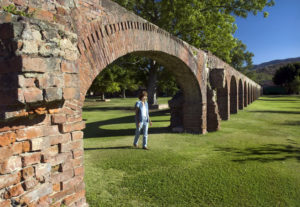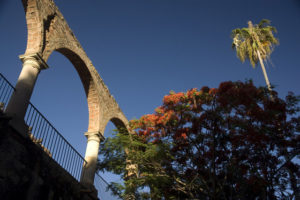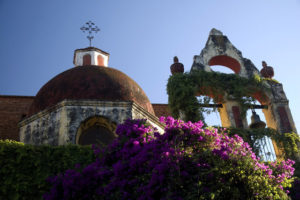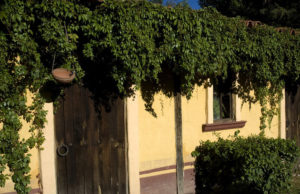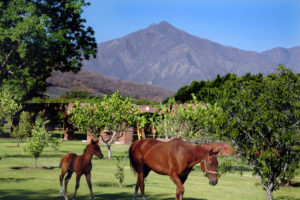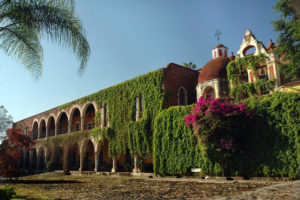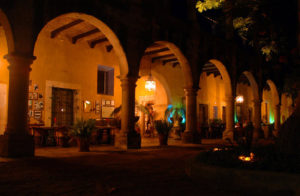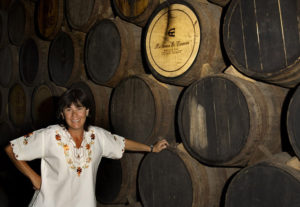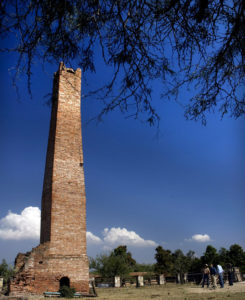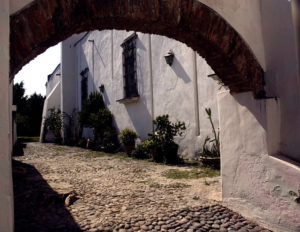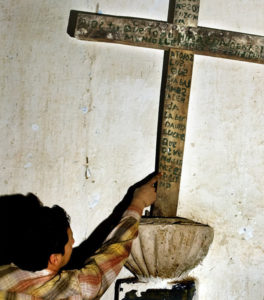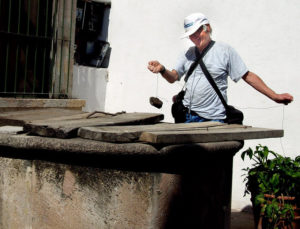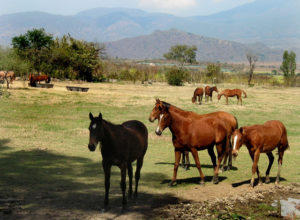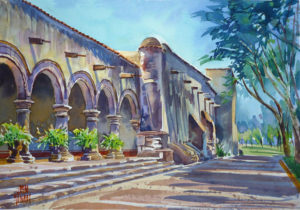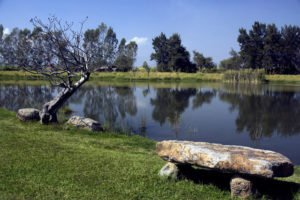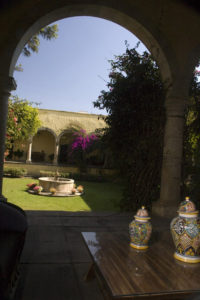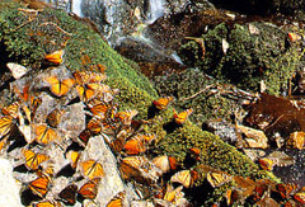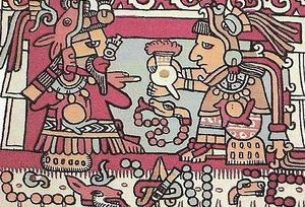Before the revolution, haciendas dotted the countryside of Mexico. With their classic architecture and splendid great houses, each Mexico hacienda is surrounded in an aura of romance.
Located 40 kilometers west of Guadalajara, the circular pyramids of Teuchitlán, attract tourists from all over the world. The “Guachimontones” are the centerpiece of several attractions in the area. I have already described Las Piedras Bola, the Great Stone Balls of Ahualulco and the tragic history of the San Marcos Train Station. There are two historic hacienda treasures of the Colonial Period, both of which are only minutes away from Teuchitlán and well worth a visit. It should be noted that both of these haciedas are now within easy reach of the Lake Chapala communities via the four-lane highway connecting Chapala to Tala.
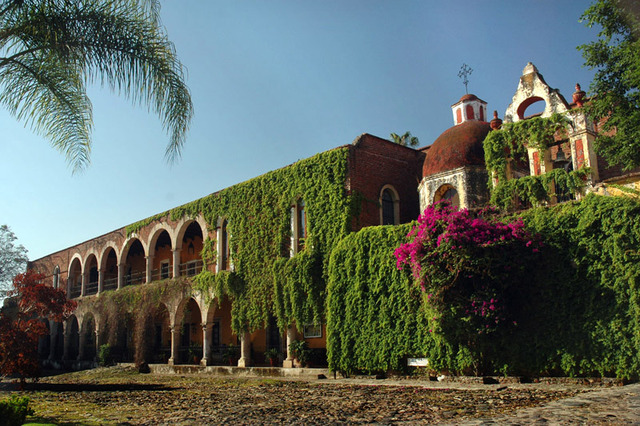
Mexico’s Hacienda El Carmen
Hacienda El Carmen has a long, fascinating history. One fine day, my wife Susy and I sat down inside a majestic arched portico with the owner and manager of the place, Mónica Baeza, who kindly took the time to tell us all about the Hacienda’s history. To be honest with you, we were frequently distracted by the grackles, robins and great kiskadees singing in the huge rubber tree shading the courtyard in front of us. But here, to the best of my recollection, is the story, as told to us by Ms. Baeza:
“Would you believe that this hacienda was built by monks? It dates back to the 16th century when the Spanish Crown bequeathed the land to one Francisco Merodio de Velasco. It stayed in the family for generations until Francisca Figueroa, a widow with no children, decided to give it to the Carmelite monks. This took place around the year 1705 and, in fact, they are the ones who constructed this finca and that beautiful courtyard out there. The Prior, however, did not want to turn it into a monastery. Instead, he sent the earnings from the cattle and crops to Guadalajara to finance the construction of the famous Convento del Carmen. Back in those days, this finca was huge. It had 22,000 hectares on which they produced corn, wheat, oats, sugar cane, mezcal and sorghum, just to name a few things.
“The fact is that this is a very rich property. It’s rich because it has an ideal climate, plenty of water and an ideal location. These three qualities are — even today — the references by which you evaluate land for agriculture.
“Now, along came Benito Juárez and the Reforma. As a result, the Carmelites were expelled around 1856. The Ley Juárez relieved the Catholic Church of all its properties. So the Convento del Carmen suddenly became the Ex-Convento del Carmen as it is known today and our hacienda fell into the hands of people who were rich and powerful back in the days of Juárez. After that, it had many owners until it suffered from neglect and was auctioned off.
“In 1964 my mother fell in love with the old place and our family bought it and developed it as a country house. So this is where I grew up, where I played with my friends. Then, in 1996, when my father became ill, we held a family meeting to decide what to do about the hacienda. Well, I ended up in charge of the place, because I raised my hand and said, ‘I’ll do it’.”
Today Hacienda el Carmen has only 160 hectares of farmland where they raise sugar cane and corn and specialize in growing large, beautiful bell peppers for exportation. In order to help keep the farm financially afloat, Baeza decided to transform the place into a first-class hotel, spa and restaurant without detracting from its colonial charm.
To us, the most surprising thing about Hacienda El Carmen was that they are not charging a fortune, as are some other restored haciendas. During the week, the price for a double room is US$ 130. This price does not include breakfast or spa services, but it does get you on the grounds and allows you to enjoy the place. If you’re interested in visiting Hacienda El Carmen, take a look their website.
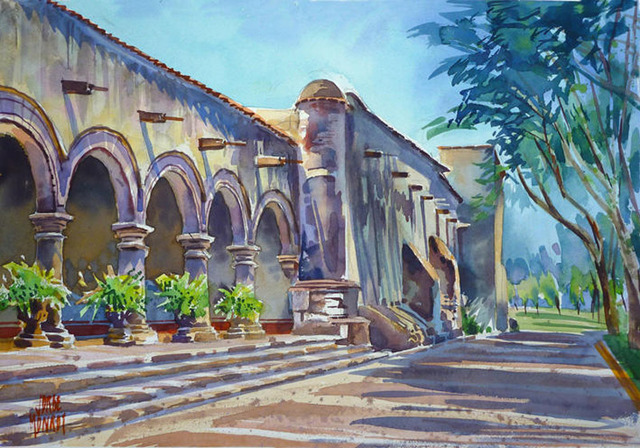
Hacienda La Labor
Hacienda Labor de Rivera has a history just as interesting as that of El Carmen, but radically different. This hacienda is located 3.3 kilometers southwest of Teuchtlián and includes a placid lake, a large chapel and a lienzo charro (rodeo ring) among its attractions. It also includes a macabre history, according to its present owner, Edgar Lucke.
It seems the Hacienda was constructed in the seventeenth century and its first owner was probably a priest named Don Nicolás de Siordia. Curiously, there seems to be no information about the place until it fell into the hands of the Camarena family in the twentieth century. At that time, according to Antonio Flores Flores, author of Odisea de un Pueblo, “La Labor de Rivera was one of the best Haciendas in the area, with excellent land, abundant water, plenty of pasture land and hard-working trabajadores. They also produced fine mezcal and later piloncillo (brown sugar). In those days, before the creation of La Vega Dam, they irrigated the best fields and reaped abundant harvests of wheat and garbanzo; they truly seemed blessed by God.”
As in so many other cases, a veritable town had grown up outside the walls of the hacienda, a community with more than 200 homes and around 1000 inhabitants. Most of them worked for the hacienda and each family raised pigs and chickens.
In 1948 a shadow was cast upon this pastoral scene. A rumor spread through the rancho that the then owner of La Labor, Don Santiago Camarena, had sold it to a “señor” from Guadalajara. “One bad day,” says Flores Flores, “a jeep with three men in it drove up to the Hacienda. The driver was a tall, brawny white man about 50 years old with a flushed face and a furtive look about him.” The man’s name was Heliodoro Ruvalcaba, but everyone referred to him as The Major, which was said to have been his rank in the army, from which he was now retired. His companions were two pistoleros named El Charro and Vergara, each of whom were armed to the teeth with automatic rifles and pistols. No sooner had they stepped from the Jeep than a barking dog ran up to them. The Major, says Flores Flores, glanced at one of his bodyguards. “Kill it; what are you waiting for?” he said and his man pulled out a 45 and shot the dog dead. This event, it seems, was a portent of things to come.
One of Major Ruvalcaba’s first acts was to have his chief wrangler shot for talking back to him. Around the same time, he decided to send away all the rancheros living on his property, after which he razed their 200 houses and planted sugar cane there. After that followed 23 years of killings. The most brutal was the murder of a man called Juan “La Iguana,” a shopkeeper in Teuchitlán. Flores Flores says the man’s crime was to have served a drink to one of the Major’s enemies.
“The Major pulled up in front of Juan’s shop and his pistoleros forced the man into the Major’s car. Upon arrival at the Hacienda, the bodyguards tortured the man by cutting off his fingers, castrating him and flaying the skin from his feet.” On the Major’s orders, they then crucified the screaming man on the bell tower where he suffered for five days in the hot sun. Two laborers heard the man’s cries and went to see what was happening. The Major had them brought before him.
“What did you see up there?” he asked.
“Nada, señor,” they answered.
“What did you hear?”
“Nada, señor,” they again replied, “Not a thing.”
“Give them a shot to calm them down,” ordered the Major to his men.
The reference was to a certain kind of injection, said to have been one of Ruvalcaba’s favorite means of making people disappear. It is not known what was in the syringe but anyone injected by the Major usually died within eight days.
Heliodoro Ruvalcaba’s reign of merciless killings and torture lasted until 1972. I could find no information on how he ended his days, but in the mid-1970s, his successor, Doña Aurora Ruvalcaba sold the property to Mr. David Lucke Cárdenas and a totally new era began.
As a postscript, Mr. Lucke’s son Edgar told us that Major Ruvalcaba is said to have dumped the bones of his many victims into the hacienda well. “Ever since then, people have claimed that the place is haunted,” he says.
Not long ago, I went to La Labor and measured the depth of this well, which turned out to have 17 meters of water. The services of a diver would probably be required to find out if the bottom of the well is really covered with bones, but it is hard to believe anyone would throw dead bodies into their main source of drinking water.
Today Hacienda La Labor grows corn and alfalfa as well as greenhouse crops, and specializes in raising and training quarter-horses. Many of the buildings have been restored and can be rented for special events like weddings.
Recently, they have begun to take hotel guests. Ten suites are available for this, but guests must book for a minimum of two nights. Rates are surprisingly reasonable for such a beautiful and historic B&B. Although there is no public restaurant or spa, arrangements can be made for meals and massages. For more information call Susana Cortés at 3 616-9198 in Guadalajara.
Note that it is no longer necessary to travel to Europe to have the experience of sleeping in a haunted castle: At Hacienda Labor de Rivera there is no extra charge for the ghosts.

